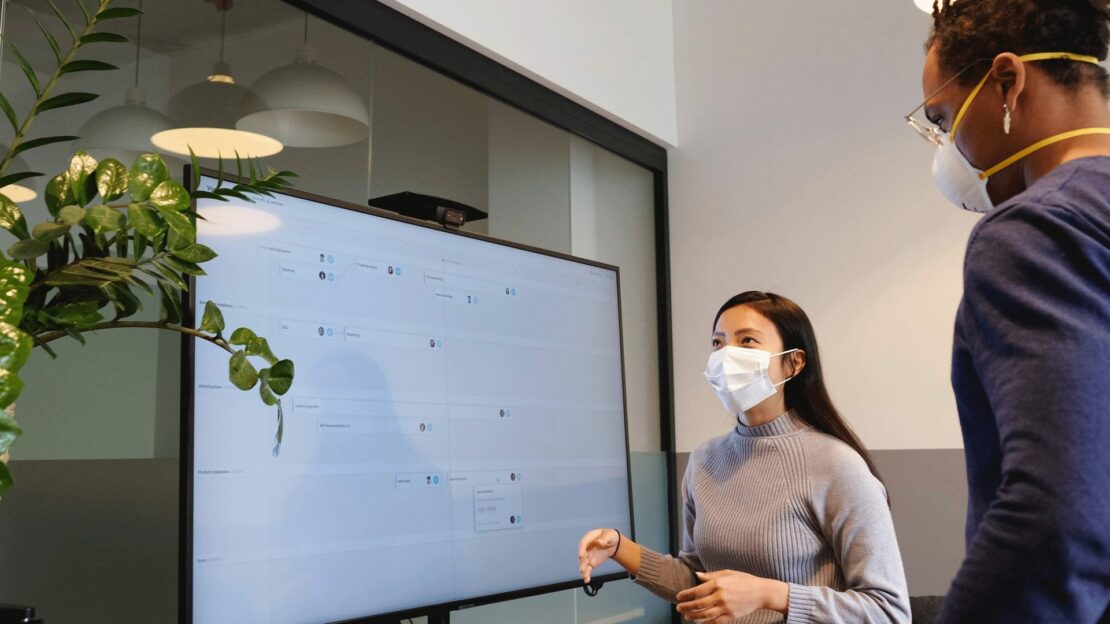How to Communicate on the World’s Biggest Political Stage
octubre 6th, 2023
Greg Marshall, Account Executive of Grayling NY, breaks down the most recent presidential debate between President Donald Trump and former Vice President Joe Biden through the lens of communications and messaging strategy, discusses new developments of Trump’s positive COVID-19 test and previews Wednesday’s Vice President debate.
2020 is not the year that anyone expected. So far, we’ve had Australian wildfires, a presidential impeachment acquittal, British royals leaving their family, a never-ending global pandemic, a stock market crash, nationwide social justice protests, UFO photos released by the Pentagon, Kim Jong Un death rumors, a Twitter hack…and don’t forget about those murder hornets.
Is your bingo board full yet?
All of these events set the stage for one of the world’s most pivotal democratic election in recent memory. Much of 2020 has been unpredictable and incomprehensible, however there is one event that almost everyone had marked on their calendars. The first presidential debate of the 2020 U.S. general election.
Traditionally, presidential candidates campaign against one another for months and rely on the first debate to publicly express their beliefs, viewpoints and policies for undecided voters on a global scale. Let’s just say that last Tuesday night’s debate between President Donald Trump (R) and Vice President Joe Biden (D) continued to transform the reformation of constructive, old-school political discussions to chaotic, new-school political feuds.
Memorable PR moments in debate history
Leading up to the first debate of each election cycle, the candidate that presents the most compelling policies, vision, poise and visual dynamic would influence undecided voters toward their campaign the most. That strategy has been successful for many candidates in years past, as many have built their campaigns on memorable moments that have captivated American voters.
As some may remember, debates weren’t always on primetime television for millions of people to watch around the country. Prior to 1960, radio was the only source for the public to listen in. The historic election of 1960 between John F. Kennedy (D) and Richard Nixon (R) ushered in a new debate era in which crafting a public image and taking advantage of media exposure became essential ingredients of a successful political campaign. Politicians have stressed style as well as substance in recent decades, knowing that their words and actions not only will appear in newspapers, television and on the internet, but will be repeated over and over in American living rooms leading up to election day.
In the 1980 election between incumbent president Jimmy Carter (D) and Ronald Reagan (R), public speaking strategy and methodical messaging started to become more mainstream with presidential candidates on the big stage. Many remember Reagan’s iconic question to the American people in his final debate before election day. “Next Tuesday, all of you will go to the polls. You’ll stand there in the polling place and make a decision. I think when you make that decision, it might be well if you would ask yourself, are you better off than you were four years ago?” This simplistic yet thought-provoking quote grasped the curiosity of many voters seeking answers and teased Reagan’s game plan toward bouncing back from one of America’s largest economic recessions in history.
Biden vs. Trump: The build-up
Fast forward to September 29, it seems like President Trump and Vice President Biden built their debate strategies a “little different” than previous candidates. When I say a little different, I actually mean completely unrecognizable and almost impossible to follow along.
Two weeks ago, moderator Chris Wallace of FOX News announced the topics he would cover, including the Supreme Court, COVID-19, the economy, social justice, Trump’s tax returns and more. This was not Wallace’s first rodeo as a debate moderator. In 2016, he was firm yet comical when trying to persuade President Trump and Hillary Clinton to stop talking simultaneously. “I’m not a potted plant here,” he said. “I do get to ask some questions.” As he took the stage to address the COVID-limited crowd and the American public at Case Western Reserve University, the irony of what he said in 2016 would turn into some notable foreshadowing.
Wallace made it clear to the American people that he was not planning to fact check the claims of each candidate when answering his questions. “My job is to be as invisible as possible,” Wallace said. “I’m trying to get them to engage, to focus on the key issues, to give people at home a sense of, ‘why I want to vote for one versus the other.’”
The Commission on Presidential Debates divided the first debate into six 15-minute segments. Wallace began each segment with an opening question and the candidates were given two minutes to answer with the opportunity to then respond to each other. This rule was not followed by either candidate, but there was no timeout corner to banish them to. Wallace was stuck and had to carry on.
Lights, Camera, Action
Immediately after Wallace asked his first question on the upcoming Supreme Court nominee decision, Trump asserted a brash delivery style as he bullied, bulldozed and obfuscated his way through the 90-minute showdown, interrupting Biden and Wallace at almost every turn. This is a tactic that has been used before, but never to this extent we saw on Tuesday. Imagine his tweets, but vocal.
Over Trump’s interruptions, Biden responded by mocking the President, calling him a “clown,” a “racist” and “the worst president America has ever had.” These were responses that we’ve rarely seen, if ever, in past debates. It was within the first five to 10 minutes of the debate that the Americans understood what the President was trying to accomplish with his communication strategy and how Biden tried to combat it. The president relentlessly attempted to throw rhetorical ammunition in hopes of igniting emotional responses from Biden – some attempts were successful, some of them dodged and avoided.
Trump continued to use heavy and aggressive rhetoric to latch Biden to the violent and destructive elements of this summer’s protests, as well as targeting Biden’s son Hunter when discussing the economy and foreign affairs.
Tuesday’s whirling dervish of a debate has already persuaded the commission to announce that it is considering some format changes for remaining debates after President Donald Trump repeatedly disregarded the rules, resulting in a chaotic debate that lacked substantive policy conversation. It is unclear exactly what changes the CPD will propose, but it has been reported that the commission is considering the ability to cut off a candidate’s microphone when rules are violated.
The night wasn’t all chaos. Instead of falling into the trap of hate and vitriol with his opponent, Biden made consistent efforts to console the American public and reach out to undecided voters with direct eye contact into his personal camera. At his calmest, Biden attempted to break the noise, and speak directly to viewers who hadn’t yet turned off their TV in frustration. He tried to present a reality check on multiple occasions.
- On the economy: “You folks living at home, how well are you doing?”
- On the white supremacist rally in Charlottesville: “Close your eyes, remember what those folks looked like coming out of the fields, carrying torches.”
- On his son Hunter’s discharge from the Navy Reserves after failing a drug test in 2014: “‘My son, like a lot of people we know at home, had a drug problem. He’s worked on it and I’m proud of him.”
- On the pandemic: “You folks at home, how many of you got up this morning and had an empty chair at the kitchen table because somebody died of COVID?”
This tactic presented a brief example of compassion, compliance, understanding and sincerity, attempting to shift the tone of the debate – from expressing political vendettas to addressing voter concerns, interests and questions.
Depending on the preferred communication style of American voters, some may support and appreciate Trump’s vindictive style of debate and some may prefer a more cordial and diplomatic style of professional public speaking. We can clearly see that political communications have been completely transformed from what they once were, influenced by a plethora of platforms, and we can see that this change has impacted how we see our politicians.
In the aftermath, six in 10 debate watchers said Biden won the debate, and just 28% say Trump did, according a CNN Poll of debate watchers conducted by SSRS. Beyond overall praise for his performance, voters who watched the debate largely said that they trusted the former vice president over the current President on major issues covered in the debate, including racial inequality (66% trust Biden more, 29% Trump), health care (66% Biden to 32% Trump), the coronavirus outbreak (64% Biden to 34% Trump) and Supreme Court nominations (54% Biden to 43% Trump). Granted there are so many polls out there from a variety of mainstream news outlets, a heavy majority of polls from undecided voters favored the former vice-president.
The impact of Trump’s COVID test on the next two presidential debates + VP debate
President Trump revealed early Friday morning via Twitter, that he and first lady, Melania Trump, had tested positive for COVID-19, throwing the nation’s leadership into uncertainty and escalating the pandemic crisis to new levels. Much of the President’s campaigning and schedule in the month of October will most likely be re-formatted and adjusted to cope with their recoveries. As of yesterday, many of Trump’s closest advisors believe the debates scheduled for October 15 and 22 will still move forward and there isn’t a reason to delay them.
About 73.1 million people watched Tuesday night’s presidential debate between Trump and Biden on television, according to Nielsen. Viewership of the debate was 13% lower than for the first presidential debate of the 2016 election cycle, when 84 million viewers tuned in to watch Trump square off against former Secretary of State Hillary Clinton. Steve Scully of C-SPAN and Kristin Welker of NBC News are still scheduled to moderate the other two presidential debates.
The next debate on the calendar for the 2020 election will be between incumbent Vice President Mike Pence (R) and California Senator Kamala Harris (D) on Wednesday, October 7. According to the Wall Street Journal, Harris intends to focus on the pandemic and access to health care, contrasting the administration’s handling of the coronavirus—and Pence’s leadership of the coronavirus task force. People familiar with Pence’s preparation said he has been preparing for the debate for weeks while navigating his official duties and a travel schedule that had him on the road several days a week. No topics or focus have been disclosed.
Take a deep breath
The twists and turns of 2020 seem to never stop, like a novel reaching its climactic peak that leaves readers wondering what the next chapter might be. We’ve learned that this election cycle has already presented multiple communication tactics to address our current events. Both campaigns continue to push heavily persuasive messaging to resonate with their audiences with no signs of slowing down this month. We all could see that last Tuesday’s debate was an instrumental building block for the inevitable, emotional and psychological culmination that is election night on November 3, 2020.


